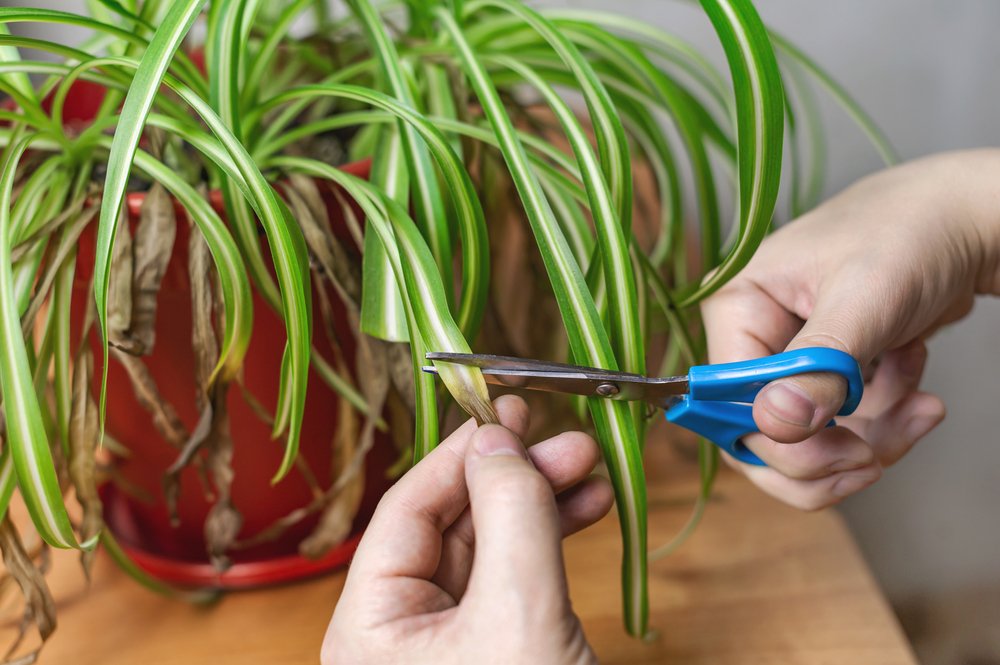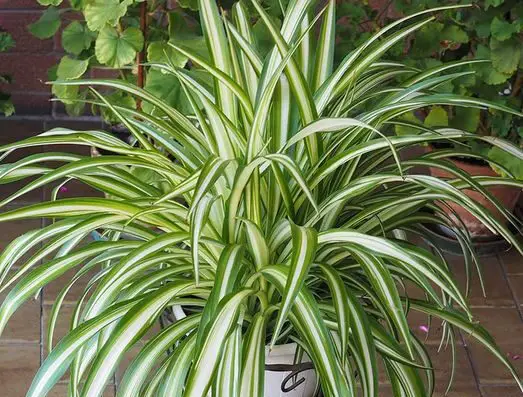The Falangio is a well-known houseplant and is also valued as an office plant both for its high decorative power and its ability to purify the environment. In fact, like ivy , fern , aloe and dragon tree , this plant belongs to the category of decontamination plants . It manages to eliminate some pollutants present in all closed environments, especially carbon monoxide and xylene. In this article we will explain many useful tips for cultivation to beautify your home while purifying the air.
Which plant is the phalanx?
Also known as spider plant, chlorophytum, nastrino or nastrina, it is a houseplant that can purify indoor air and decorate rooms thanks to the beauty of its leaves.
Its scientific name is Chlorophytum and it is an evergreen plant from the Agavaceae family.
Its whitish roots are fibrous and tuberous. The above-ground part is very picturesque and consists of numerous green, lanceolate leaves, often variegated with white. They are long and narrow, can grow up to 60 cm long and form a central rosette. They are grouped in thick, dense tufts of feathers. In spring, new stems appear that are very long and drooping.
diversity
Three types of hybrids are cultivated, all of which have an ornamental function:
- C. comosum – the most common variety with white stems, green leaves with wavy edges and small, odorless white flowers
- C. undulatum : Its leaves are rough and narrow, with hardened edges. The spike-shaped flowers are white with red veins.
- C. laxum : small variety with deep green leaves and white edges. The flowers are collected in panicles.
Phalanx: plant care
The plant is quite resilient and quite easy to care for. It can be grown both in pots and in the ground. Let’s see what ideal conditions exist for cultivation.
If grown in a pot, we recommend keeping it indoors in the warmer months, while moving it outside in the fall months, always monitoring the temperatures; If, on the other hand, you want to place it on the ground, you must ensure that the temperature does not drop below 7 ° C and that the phalanx is well protected from the sun.
- Climate : fears both the cold (temperatures below 5°C) and excessive heat (temperatures above 28°C). To give an idea, the ideal temperature is between 20°C and 25°C during the day and between 15°C and 20°C at night. For specimens grown during the event, it is advisable to remove them indoors during the hottest season, and take them outdoors again with the arrival of autumn.
- Exposure : Although it requires abundant light, it does not like direct sunlight which can burn its splendid leaves. For these reasons, it should be placed in a cool, bright and cool place, away from sunlight and wind. It also grows well in partial shade.
- Soil : The ideal potting soil consists of a mixture of equal parts universal potting soil , sand and peat moss . However, it can also grow well in any other type of soil.
- Fertilization : during the vegetative phase, every 15 days it is necessary to administer a liquid fertilizer with quantities of nitrogen greater than those of phosphorus and potassium. Alternatively, a slow-release granular fertilizer every 60 days may also work.
- Pruning : more than a true pruning, it is good to carry out regular cleaning by removing damaged or weakened parts.
How to water the phalanx.
Quite resistant, it can withstand brief periods of drought. On the other hand, however, it does not like stagnant water inside the saucer. Given this, it is advisable to water it moderately and taking care to eliminate excess water that settles at the bottom of the plate. As an indication, one watering per week may be sufficient during winter; in the summer a couple more times. In any case, between one watering and another you should always wait for the soil to dry completely.
Always use lime-free water at room temperature. Rainwater or distilled water is perfect.
It is very important to vaporize the water on the leaves, especially in very hot and dry times. That is, in summer and when the heating and air conditioning systems are active in the house.
Phalanx, reproduction
The multiplication is carried out by dividing the locks. The procedure is very easy. All you need to do is take the tips of the side branches from the mother plant and transplant them immediately afterwards into cool, loose, draining soil. This operation can be carried out at any time of the year, although spring is preferred.
When to transplant Phalanx
When the roots of the plant begin to emerge through the drainage holes of the pot, it is time to move the plant to another container, larger than the previous one in both height and length. Obviously, new soil must be used for transplanting.
plagues and diseases
Although it is a strong and resistant plant, the phalanx can be affected by parasites and diseases. Specifically, its most common enemies are the red spider, the mealybug and fungal attacks that can cause leaf and root rot.

phalanx, use
It is a long-lived plant with high ornamental power. For this reason, it is often planted outdoors in flower beds or to create garden borders. Thanks to the hanging habit of its long leaves, it is also perfect for hanging in hanging baskets and baskets, as a hanging plant. Finally, thanks to its well-known purifying capacity, it is also perfect as an indoor plant.
meaning of the phalanx
In the language of flowers it symbolizes perennial youth.
Is it a poisonous plant?
It is not included in the list of poisonous plants. In fact, it is edible for cats and is also highly appreciated by them.
How much does a Falangio plant cost?
In addition to being useful and very decorative, it is also a very economical plant. In fact, online you can find seedlings for less than 5.00 euros.
Dry phalanx tips
One of the most common problems with this plant is the wilting of the tips of its leaves. The causes can be many and varied. Let’s analyze them in detail.
- Water imbalance : overwatering or giving too little water can cause the same problem. Therefore, make sure you always give it the appropriate amount of water, also depending on the different seasons of the year, and always check that the soil is well drained.
- Water that is too hard , that is, rich in extra minerals and other elements that have not been filtered. Tap water is generally defined as hard because it is full of lime. Using this type of water to water plants can overly acidify the soil or provide the plant with nutrients it doesn’t actually need. If your tap water is very hard, try using distilled or rain water from time to time.
- Direct exposure to the sun : the phalanx needs a lot of light especially for the vigorous growth of its beautiful leaves. However, it cannot withstand direct sunlight: the soil, in fact, dries out too quickly and is therefore deprived of the moisture it needs.
- Diseases : Leaf blight affects plants when the environment is too hot and/or humid. In this case, brown spots appear on the leaves, which then gradually turn black. Dry and stained leaves must be removed immediately, otherwise they will infect healthy ones.

Phalanx, yellow leaves
Now let’s see what may be the reasons why the leaves of the Falangium begin to turn yellow.
- Attack by parasites , especially aphids , red spiders, yellow spiders, mealybugs , which generally settle on the underside of leaves and fungi that can cause rotting of leaves and roots. If pests are present, wash the leaves with horticultural soap, such as mild potassium soap , and then rinse all leaves thoroughly. Then place the plant in a well-ventilated area to let the leaves dry.
- Excess minerals or fertilizers . If you doubt that any of these are the cause, renew the soil at least once a year
- Too little light : As a result, the leaves do not receive the chlorophyll necessary for the classic green color.
- Nutritional deficiency – change the soil regularly and keep it fertilized
- Root rot : avoid excessive watering and wait for the soil to dry to half a centimeter deep before proceeding with the next watering
phalanx, hydroculture
It is a plant that can also be easily grown using the hydroculture system . Let’s see how to do it. From a healthy, well-developed mother plant, delicately cut new seedlings with sterilized, well-sharpened scissors. The cut should be made close to the leaves. In the meantime, get yourself some small glass containers with not too wide mouths. Fill them halfway or three-quarters full with water. At this point, place each freshly cut seedling into each jar. Attention: only the base of the seedling should remain submerged in water; a large part of the foliage, on the other hand, should remain outside, in an upright position with the leaves facing upward.
Place the jars in a very bright environment but away from direct sunlight. Change the water every 5 days (even sooner if it becomes cloudy) using room temperature water.
In one, two weeks maximum, the roots will have formed. If desired, it is possible to help the plant with adequate nutrients: once a month, administer half a teaspoon of fertilizer diluted in 3.5 liters of water. If the leaves begin to turn yellow or dry, stop treatment immediately.


